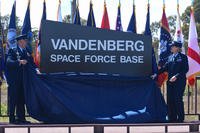ANDERSEN SOUTH, Guam — Approaching the decrepit buildings, gas masks donned and cleared, a company of Marines prepared to clear a town that may have been contaminated. Hearing only the sound of their own breath entering and exiting the chambers of the masks, the Marines secured the town and waited for the arrival of the chemical, biological, radiological and nuclear specialists to check contamination levels.
Marines and Sailors from Company G., Battalion Landing Team 2nd Battalion, 1st Marine Regiment, and Combat Logistics Battalion 31, both from the 31st Marine Expeditionary Unit conducted a helicopter raid on a potentially hazardous town here, September 22.
The mission called for the Marines to wear their M-50 joint service all purpose masks because of the possible chemical contamination within the area while performing their mission.
“First, you have to break the mask out of its carrying bag,” said Lance Cpl. Tristan Schnabel, a team leader with Co. F., BLT 2/1, 31st MEU and a native of Des Plaines, Ill. “Once the mask is out, you have eight seconds to don and clear your mask.”
The Marines and Sailors had to conduct a foot patrol up to a town and clear several buildings while wearing their masks. Difficulties were inevitable.
“When my team was clearing the buildings, we were moving fast, causing the lens to fog,” said Schnabel. “When you are breathing hard, all you can hear is your breath entering and exiting the mask’s chambers.”
Once the area was secured and there was no longer a contamination threat, the BLT’s mission was to provide security while CBRN specialists came in and tested the contaminated area.
The CBRN Marines moved to the building that was suspected to contain hazardous material. Using a wide array of analyzing tools, they verified if the reported building had harmful material. Wearing full suits to protect them from the hazardous material, the Marines used the training to brush up on their skills.
“Neutralizing a harmful threat of hazardous material is a big part of our job that needs to be practiced continuously,” said Lance Cpl. Briana Waldorf, a CBRN specialist with CLB-31 and a native of Tampa Bay, Florida. “We have to be ready to work together with the BLT to neutralize a possible (CBRN) threat the 31st MEU comes across.”
The CBRN Marines utilized their equipment to hunt down and find the source of the harmful material and mark the area properly. Once CBRN’s mission was completed and all the enemies were neutralized, Co. G. withdrew from the area.
The 31st MEU continuously trains in order to improve the coordination within the full spectrum of the 31st MEU’s capabilities, from humanitarian assistance to full on amphibious assaults and raids, while at the same time building the individual Marine’s proficiency.
The 31st MEU is the only continuously forward-deployed MEU and is the Marine Corps’ force in readiness in the Asia-Pacific region.

























